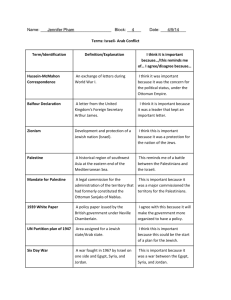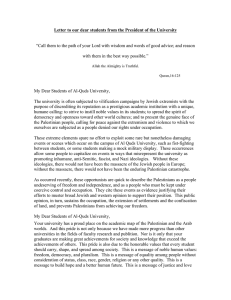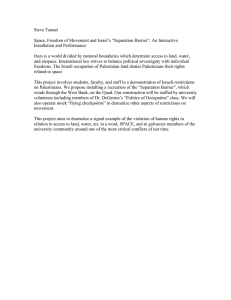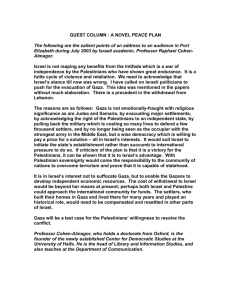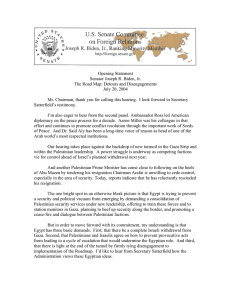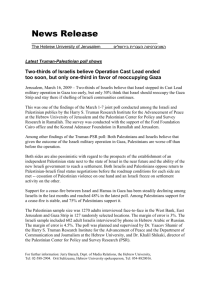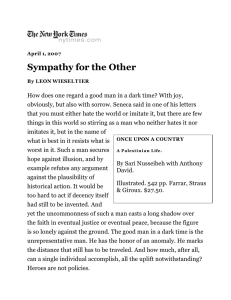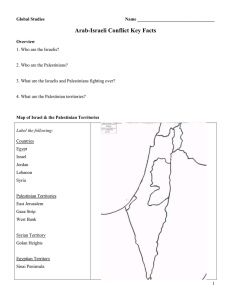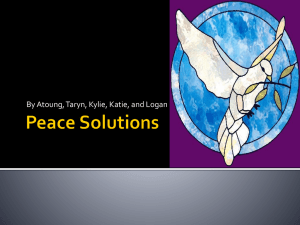Israel-Palestine Conflict: History, Religion, Territory, Economy
advertisement
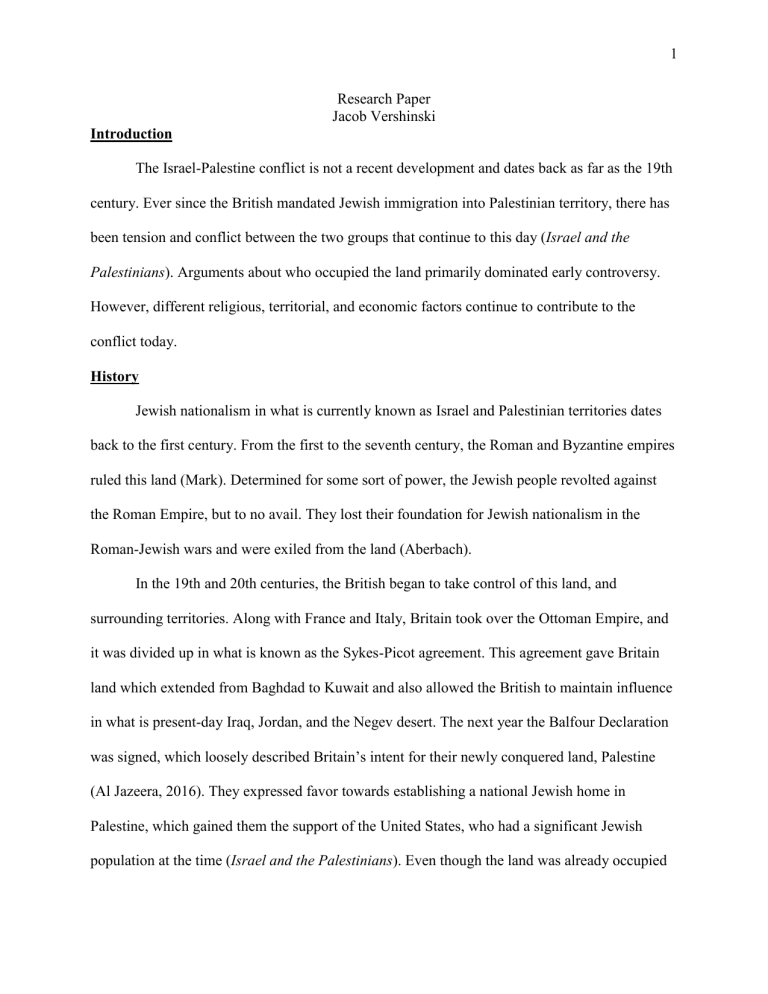
1 Research Paper Jacob Vershinski Introduction The Israel-Palestine conflict is not a recent development and dates back as far as the 19th century. Ever since the British mandated Jewish immigration into Palestinian territory, there has been tension and conflict between the two groups that continue to this day (Israel and the Palestinians). Arguments about who occupied the land primarily dominated early controversy. However, different religious, territorial, and economic factors continue to contribute to the conflict today. History Jewish nationalism in what is currently known as Israel and Palestinian territories dates back to the first century. From the first to the seventh century, the Roman and Byzantine empires ruled this land (Mark). Determined for some sort of power, the Jewish people revolted against the Roman Empire, but to no avail. They lost their foundation for Jewish nationalism in the Roman-Jewish wars and were exiled from the land (Aberbach). In the 19th and 20th centuries, the British began to take control of this land, and surrounding territories. Along with France and Italy, Britain took over the Ottoman Empire, and it was divided up in what is known as the Sykes-Picot agreement. This agreement gave Britain land which extended from Baghdad to Kuwait and also allowed the British to maintain influence in what is present-day Iraq, Jordan, and the Negev desert. The next year the Balfour Declaration was signed, which loosely described Britain’s intent for their newly conquered land, Palestine (Al Jazeera, 2016). They expressed favor towards establishing a national Jewish home in Palestine, which gained them the support of the United States, who had a significant Jewish population at the time (Israel and the Palestinians). Even though the land was already occupied 2 by Palestinian people, the British still regulated Jewish immigration into the region. In the years that followed, conflict broke out, while both Jewish and Arab populations skyrocketed (Handelman, 2011). However, the Jewish immigration was exceeding the natural population growth of the Arabs, causing increased concern. This only heightened tension and conflict between the two communities. As time progressed, the Jewish and British fought against the Arabs, causing them to weaken. When World War II occurred, the British shifted their focus away from facilitating Jewish immigration, to preventing it, to gain the support of the Arabs during the war (Israel and the Palestinians). This allowed the booming Jewish population to gain their own stability and mobilize to attack the British. In 1947, after a few years of battle, the British retreated out of Palestine, allowing the Jewish population to gain control (Handelman, 2011). In 1948, Zionist leader David Ben-Guiron declared Israel an independent state, to which he received attacks from Egypt, Iraq, Transjordan, Lebanon, the Palestinians, and Syria (Weiner, 1999). The Arab’s military quality and fighting power were poor, and therefore they lost the fight. This allowed the Jews to expand their territory to include all of British-run Palestine, except for the West Bank, Gaza Strip, and East Jerusalem. Conflict continued through the 20th century producing two wars: the Six-Day War and the Yom-Kippur War. In 1987, Palestinian frustration led to an uprising in Gaza and the West Bank. Violence erupted as the Israelis responded with lethal force. However, Israel’s military power was not very effective against demonstrations, which led to an agreement in 1993 that gave temporary peace between Israel and the Palestinians (Israel and the Palestinians). This didn’t last long as extremists, who refused to accept any form of compromise, took control and violence once again erupted. This violence has continued in waves until the 3 present day. Attacks by one side mediate retaliation, leading to what seems like a never-ending cycle. Religion and Rumors Religion plays a very large role in the Israel and Palestine conflicts. First, let’s examine a place that can be argued as one of the holiest cities on earth, Jerusalem. Jerusalem, which is on the border between Israel and the West Bank, plays a crucial role for both the Jewish and Muslim people. In Jerusalem, there are three major holy sites for various religions: the Al-Aqsa Mosque for the Muslims, the Western Wall for the Jews, and the Church of the Holy Sepulchre for the Christians. The Al-Aqsa mosque is the third holiest site in the world for Muslims, making it of extreme importance to them. The Western Wall is part of the holiest site in the world for Jews, also making it crucial to their religion (Schulson, 2019). With two enemies in close proximity to each other and their holy sites, conflict ensues. Also, both sides try to claim Jerusalem as their capital, only furthering the conflict between the two (Schulson, 2019). Besides the holy site of Jerusalem, we can also look at the practice of each religion. For example, extremely religious Zionists in Israel “increasingly see themselves as guardians and definers of the how the Jewish state should be” (Religion and the Israel-Palestinian Conflict). Even though these individuals are not truly the guardians of how the Jewish state is, they still contribute to the religious conflict because they appear to be very strict in anything that deals with the Arabs. On the other side, Islamic groups in Palestine are encouraging violence against the Jewish people in Israel. The Israeli people are divided against each other. Additionally, religious-based rumors started by extremists on both sides and spread through the media only further provoke conflict. For example, there are rumors of a Jewish plan 4 to destroy the Al-Aqsa mosque to build a third Jewish temple on the ruins. On the other hand, there are rumors that Muslims hold Jewish annihilation at the core of their beliefs (Religion and the Israel-Palestinian Conflict). Even though these seem to be rumors, they still spark controversy because nobody knows what to believe! Let’s say both sides deny these rumors. Who is to say that they are telling the truth? Maybe they are just saying that to calm tensions or to lower the guard of the other side. While I personally believe these rumors to be nothing more than fiction, they are still a contributing factor to the constant conflict between Israel and Palestinians. Territory and Occupation The debate of territory between Israelis and Palestinians seems to be the primary source of the conflict. The British-controlled immigration of Jewish people into Palestinian land appears to be the root of the problem. The British nor the Jews discussed how the Palestinians would feel about sharing the land. They just went right ahead and started moving in. From the Palestinian point of view, this is wrong as they were there first, they believe that they have rightful ownership of the land, and they don’t want to share it. This is why the Palestinians tried to rebel against the British and the Jews initially. From the Jewish point of view, they are returning to a place with historical significance, and they have an ally to help them get there (Israel and the Palestinians). In fact, the Jewish people tried to establish independence hundreds of years before the Palestinians were even there. They believe that it is their rightful place to set up an independent state. With both sides believing they have the right to be in control of this land, conflict arose. Additionally, after the Six-Day War, Israel gained access into the Gaza Strip, the West Bank, and East Jerusalem, and they have maintained control ever since. This is an issue because 5 the Palestinians, who were initially there, had no place to go and they are still living there, under the occupation of Israel (Shafir, 2017). This causes tension because the Palestinians have what they consider to be their enemies in their land. With no place to turn to, the Palestinians continue to encourage conflict as they see Israeli forces intruding on their land. However, this constant conflict has more behind it than just land controversy. Economic Impacts While land distribution and occupation is a highly debated topic between Israelis and Palestinians, there are profound impacts that result from this. For instance, there is both a cost to Israel and a cost to the Palestinians for the Israeli occupation. It has been projected that between 1970-2008, the total cost of the Israeli occupation totaled over $100 billion (Costs of Israeli Occupation, 2015). This is so severe to the Israeli economy that if it weren’t for international support, the occupation would’ve ended long ago. The main portion of this cost appears to be for security issues, indicating that the Palestinian revolts are actually causing a rise in the cost of occupation (Swriski, 2005). With no foreseeable end to Palestinian resistance, one can only imagine this cost will increase. However, the Palestinian resistance to the Israeli occupation is causing detrimental effects for themselves too. With Hamas continuing to revolt in the Gaza Strip, the violence has led to the closing of the Israeli border to the Palestinians, causing a decrease in trade and employment (Naqib, 2000). Also, when the Israelis began their occupation of the West Bank and Gaza Strip, they brought along their own economy, which is much larger and more well established than the Palestinian’s. While some can view the good in this, as it stimulated trade and increased demand for products, there is also the possibility of competition, which could crush the Palestinian’s economy. 6 Next, along with the Israeli occupation came tariffs. Immediately after the occupation began, Israel implemented a “custom union trade arrangement that increased tariffs approximately fourfold” (Naqib, 2000). This led to a decrease in Palestinian world trading and an increase in trading with Israel, effectively eliminating any advantage they had in the market. This also stimulated the Israeli economy, while limiting the Palestinian economy. Israel has also been known to hire Palestinians to work in Israel (Naqib, 2000). This effectively means Israel controls their wages, and thus their economy. Finally, if we look at the land occupied by Israel, specifically the Gaza Strip, it is located on the Mediterranean Sea. This means it has ports for exporting and importing goods, a site for international trade. With this in mind, we can see that the Gaza Strip plays a very important role for the economy of the Palestinians, but also for the Israelis occupying the Gaza Strip. Solutions to the Conflict and IR Theories When it comes to solving this conflict between Israel and the Palestinians, many issues would need to be resolved, and approved by both sides. This ongoing battle relies on realism: the theory that supports conflict and raw power as the predominant forces to solve any issues. Both sides have been using military power and violence to battle. Israel uses their military power to maintain the occupation of Palestinian territories, while the Palestinians use their power to cause chaos and revolt against the Israelis. Both sides focus on conflict and have been doing so for such a long time that it would be very difficult to try to persuade them otherwise. The first problem is Jerusalem. Both Israelis and Palestinians claim Jerusalem as their capital. It also proves to be a significant holy site for both communities. Making it an international city run by the EU is one solution, but having both sides approve of that might be a little more difficult. 7 Next, there is an issue with how to separate Israel and Palestine, and if a two-state solution is even plausible. When trying to divide the land, we need to think about settlements by Israelis in Occupied Palestinian Territories. Should the settlements stay in the land, and the Palestinians get the remaining territory? Or should the Israelis get kicked out and be forced to return the West Bank, Gaza Strip, and East Jerusalem? We also need to think about if the Palestinians should get some sort of compensation for the land they’ve lost to Israel. Would Israel be willing to give the land back, or even pay compensation? If Israel does pay for the land, would the Palestinians accept it? Could there be peace between the two given their history of hatred? A two-state solution may seem like the best option on the surface: split up the two conflicting countries and the fighting should end. However, it is not as easy as that. Both sides need to agree to a solution, sustain the solution, and be encouraged to prevent a future conflict from emerging. These are only a few of the problems when it comes to solving this issue. Conclusion The Israel-Palestine conflict dates back as early as when the Jewish people started migrating into Palestinian land via the British. Palestinians didn’t want to share their land, and revolts began. However, with the British backing them, the Jewish people soon became very powerful, overthrew the British, and took control themselves (Israel and the Palestinians). Many countries have attacked the Jewish people in Israel in an attempt to shut them down, but none have succeeded. As time went on, so did the conflict between Israel and the Palestinian people, only growing as the years passed. Religious, territorial, and economic factors all continue to contribute to the conflict between the two communities, and there doesn’t seem to be an end in sight. Any resolution proves to be no more than just an idea, but this can’t keep up forever. So, when will it end? 8 References Aberbach, D. (2000), The Roman—Jewish Wars and Hebrew Cultural Nationalism. Nations and Nationalism, 6: 347-362. https://doi.org/10.1111/j.1354-5078.2000.00347.x Costs of Israeli Occupation. Fanack.com. (2015, Sep 11). (https://fanack.com/arabpalestinian-israeli-conflict/costs-israeli-occupation/#bill. Handelman, S. (2011). Conflict and peacemaking in israel-palestine : Theory and application. ProQuest Ebook Central https://ebookcentral.proquest.com Israel and the Palestinians: a history of conflict in 8 key episodes. History Extra. (2021, May 19). https://www.historyextra.com/period/20th-century/israel-palestinians-history-milestonesconflict/ Jazeera, A. (n.d.). A century on: Why Arabs resent Sykes-Picot. Why Arabs resent Sykes-Picot. https://interactive.aljazeera.com/aje/2016/sykes-picot-100-years-middle-eastmap/index.html. Mark, J. J. (2021, May 22). Palestine. World History Encyclopedia. https://www.worldhistory.org/palestine/. Naqib, F., & Economic Research Forum for the Arab Countries, Iran, and Turkey. (2000). Economic relations between Palestine and Israel during the occupation era and the period of limited self rule. Cairo, Egypt: Economic Research Forum. Religion and the Israel-Palestinian Conflict: Cause, Consequence, and Cure. The Washington Institute. (n.d.). https://www.washingtoninstitute.org/policyanalysis/religion-and-israel-palestinian-conflict-cause-consequence-and-cure. Schulson, M. (2019, April 29). Why Jerusalem is so important to Muslims, Christians and Jews. The Washington Post. https://www.washingtonpost.com/news/acts-offaith/wp/2017/12/06/questions-about-jerusalem-you-were-afraid-to-ask/. SHAFIR, G. (2017). What Is the Occupation? In A Half Century of Occupation: Israel, Palestine, and the World's Most Intractable Conflict (pp. 10-83). Oakland, California: University of California Press. Retrieved May 25, 2021, from http://www.jstor.org/stable/10.1525/j.ctv1xxrn1.6 Swirski, S. (2005). The Price of Occupation The Cost of the Occupation to Israeli Society. Palestine-Israel Journal of Politics, Economics & Culture, 12(1), 110–120. 9 Weiner, J. (1999). Israel, palestine, and the oslo accords. Fordham International Law Journal, 23(1), 230-274.
